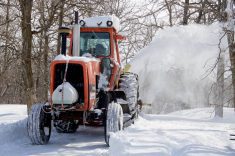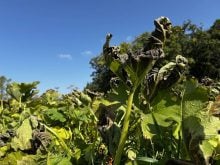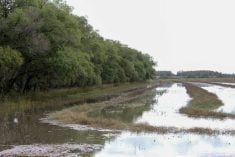Late last winter a farmer friend shared his concern about the 2021 growing season.
We’d had almost no snow in southern Manitoba and the previous fall and summer had been dry too. It felt like drought. He was right.
As someone present for both I’d say 2021 was the worst drought here since 1988.
This past summer was Winnipeg’s warmest (June 1 to August 31) since 1988 averaging 20.2 C compared to the normal of 18.4 C, Rob Paola, a retired Environment and Climate Change Canada meteorologist, said in a tweet.
Read Also
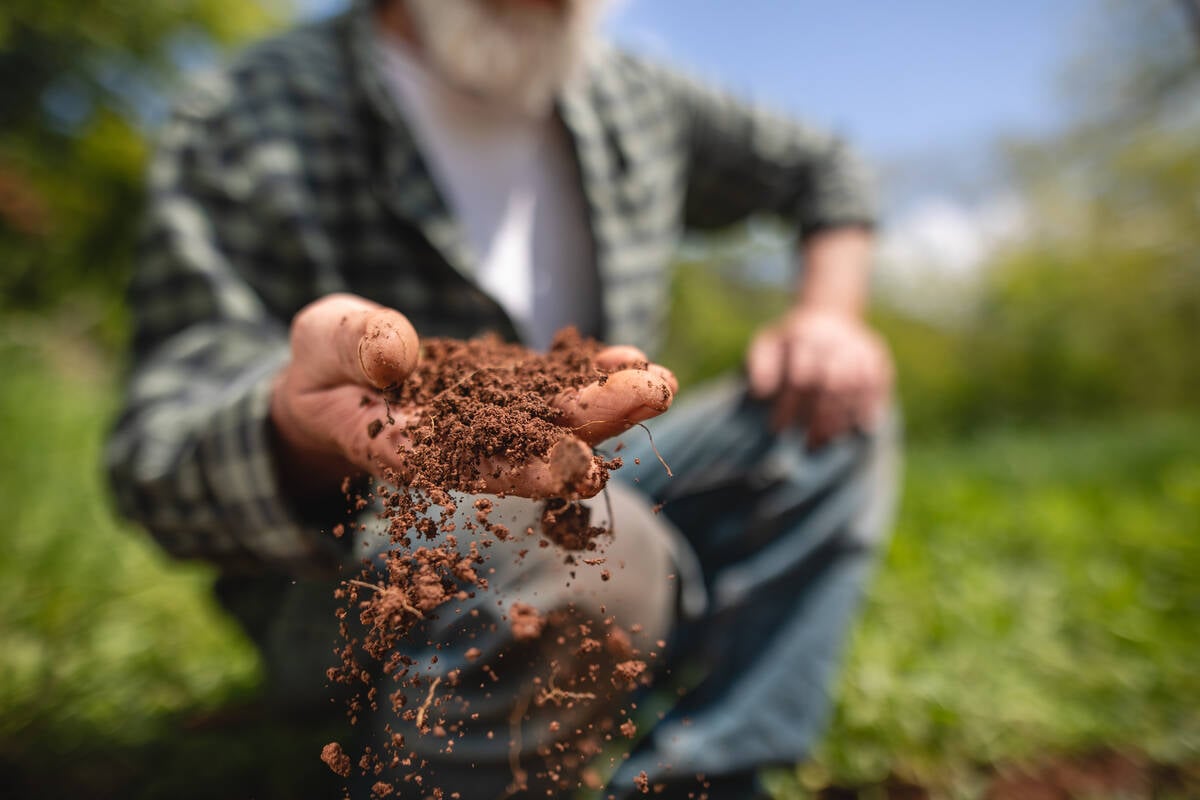
Finally getting paid for sustainable farming?
Alberta project says they might have a line on a workable ecosystem credit model to reward farmers for sustainability, and Manitoba might be next
“It tied for fourth warmest since 1873 (when record-keeping began and tied 1955),” he wrote.
“Precip-wise we were on pace for the third-driest summer on record but 101 mm (3.98 inches) of rain from Aug. 20 to 27 dropped it to 43rd place. A memorable hot, dry summer with a wet finish.”
For most crops that August rain came too late. It likely helped plump up late-maturing crops such as corn, soybeans and sunflowers.
The only Winnipeg summers hotter than 2021 were 1988 with an average temperature of 21.1 C, 1983 (20.6 C) and 1961 (20.4 C).
In 2021 there were 34 days in Winnipeg — 33 of them between June and the end of August — when the temperature hit 30 C or higher tying 1961 for second place.
The record for 30 C or plus days was 1988 at 35.
Western Canada’s drought, along with wildfires and flooding in British Columbia, dominated national headlines.
The 2022 edition of Yield Manitoba in February will do a deep dive into Manitoba’s 2021 crop production, but Statistics Canada’s Dec. 3 report confirmed what we all suspected — on average, Manitoba crop yields were down from 2020 and below the 10-year average.
Given how dry and hot it was I expected worse.
StatCan put average Manitoba spring wheat and canola yields at 47.9 and 27.9 bushels an acre down 22 and 28 per cent, respectively from 2020 and 14 and 26 lower than the 10-year crop insured average (see below).
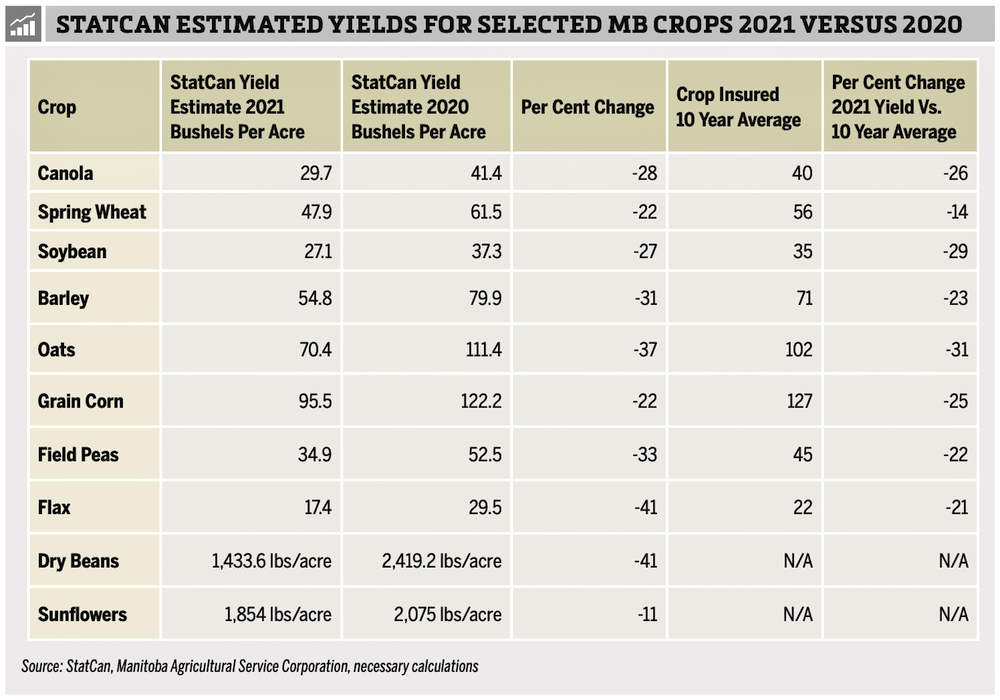
The report also shows most Manitoba yields in 2021 were above those in Saskatchewan and Alberta (see below).
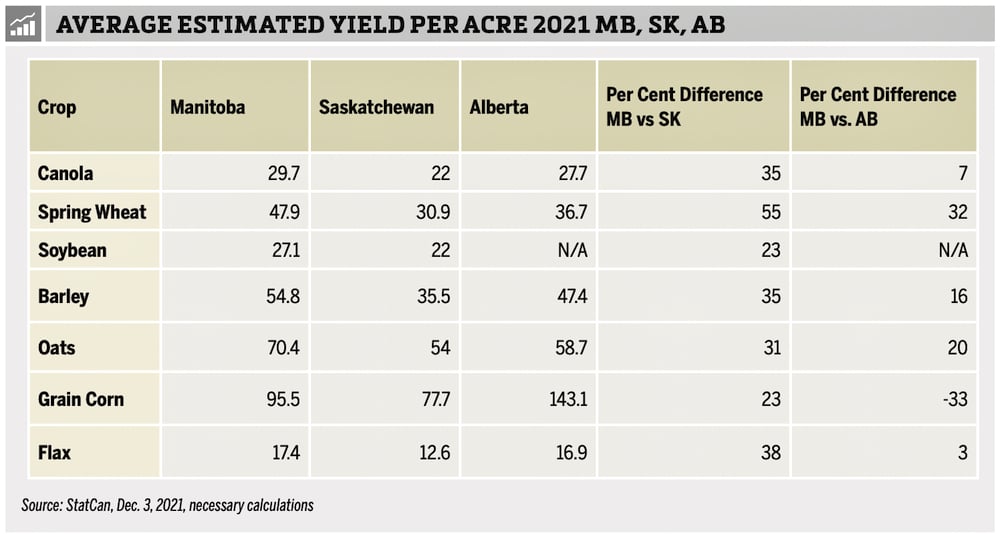
For example StatCan put Saskatchewan and Alberta’s spring wheat yields at 30.9 and 36.7 bushels an acre.
Manitoba canola averaged almost 30 bushels an acre compared to just 22 in Saskatchewan.
Some Manitoba crops did better than others. While StatCan’s average yield for sunflowers is down 11 per cent from 2020, dry bean yields fell 41 per cent.
However, averages belie how individual farmers fared. It depended on the rain and when it came.
One farmer in the RM of Lorne told me he didn’t expect to collect any crop insurance.
Another in the RM of Thompson said he’d likely collect on every crop. But between what he harvested, higher crop prices and crop insurance payments he expected to be as well, or better off financially, than in 2020.
But not all Manitoba farmers were as lucky. Anecdotal reports put some Interlake canola fields as low as five bushels an acre.
Even around Carman and Starbuck, where failures are rare, there were reports of canola averaging 15 bushels an acre.
One young farmer confided he had never experienced such a low yield.
“It was embarrassing,” he said.
If low yields weren’t bad enough some farmers trying to lock in attractive prices for fall delivery, sold more crop than they grew.
Normally farmers can buy crop from another farmer to fulfil their contract when short. But with crop production across the West reduced in 2021 that wasn’t easy.
Moreover, post-harvest prices were higher than what many farmers priced at. That’s why buying out a contract is so much more expensive than usual.
This spring I was hoping for another good crop. The previous three or four growing seasons had been dry too, but miraculously thanks to fall and winter moisture and timely rains, Manitoba farmers, on average, harvested bumper crops. Perhaps 2021 would be the same.
In fact, we’d had bumper crops for a decade or more — the last few with less-than-average rainfall. Improved genetics and agronomy were credited.
I define a ‘bumper crop’ as one yielding above the 10-year average. Twelve of the 13 main crops harvested in Manitoba in 2020, on average, exceeded the 10-year average. The main exception was canola.
Nine of the 13 crops exceeded the 10-year average in both 2019 and 2018.
In 2017, 11 of the 13 crops exceeded the average.
In April I’d never seen our dugout near Altamont so low. We deepened it — something I’d done the last time it was so dry. It was enough to make the grazing season, but barely.
The slough feeding the dugout was the driest I’d ever seen it too. I didn’t need chest waders to check the fence that runs through it.
Like many I was hoping for timely rains.
With so little snow farmers in many areas were seeding in April, but the soil was cold, delaying crop emergence rendering canola susceptible to flea beetle attacks as seed-applied insecticide efficacy waned.
It was also windy, robbing fields of the little moisture that was there.
Where I live near Miami, it remained dry until June 9 when we received 2.7 inches of rain — our first major precipitation of the 2021 growing season.
Our rain gauge showed just 1.05 inches of rain in May. We had five rains, with the biggest being just 0.3 inch May 2. It never rained again until May 20.
We received 4.5 inches of rain in June, including that 2.7 inches June 9. It was our first good soaking and there was even some run-off.
June was a wild ride with Winkler recording a record 40 C June 4 and much of the province close to, or even just below freezing, June 21.
We received 4.5 inches of rain in June. Had there been more timely rains in July crops around here probably would have done better. Instead we received three rains totalling just 0.8 inch.
August was better with a total of 3.65 inches, but it was too late for a lot of crops, especially the canola where July heat no doubt caused many flowers to abort.
September was relatively dry here with just 1.34 inches of rain.
Another 4.1 inches fell in October. It didn’t help crops, but it got weeds and volunteer crops growing and put some moisture back into the soil.
Manitoba Agriculture and Resource Development’s soil moisture map at freeze in November shows much of agro-Manitoba at 60 to 100 per cent of available water-holding capacity at a depth of zero to 120 cm.
However, it also puts much of the Red River Valley and the Interlake at 40 to 60 per cent.
And there are some spots rated at just zero to 20 per cent.
We’re all looking for snow this winter — preferably the wet, heavy kind we sometimes see in March — and a slow, spring thaw.
As much as land used for annual crop production needs moisture, all the sloughs and wetlands are even in more desperate need of recharge.
Fingers crossed.





